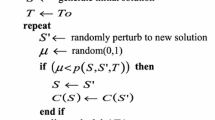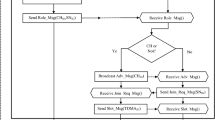Abstract
This paper introduces a nonlinear integer programming model for the clustering problem in wireless sensor networks, with a threefold contribution. First, all factors that may influence the energy consumption of clustering protocols, such as cluster-heads selection and distribution, are considered implicitly in the model. Second, an innovative fitness function that directly maximizes the WSN lifetime is proposed. Finally, a global optimum of the whole network lifespan clustering schemes is targeted. The proposed model is then solved by a particle swarm optimization meta-heuristic based algorithm. This algorithm follows a centralized one-step off-line approach, in which the clustering schemes of the whole network lifetime and their associated durations are computed at the initialization of the network operations. The one-step approach is enabled by an energy prediction mechanism that allows to reduce the costs of the periodic network re-clustering. Simulation results show clear enhancement in network lifespan and number of received data packets as compared to some state-of-the-art clustering approaches.











Similar content being viewed by others
References
Abbasi, A. A., & Younis, M. (2007). A survey on clustering algorithms for wireless sensor networks. Computer Communications, Network Coverage and Routing Schemes for Wireless Sensor Networks, 30(14–15), 2826–2841.
Akyildiz, I., Su, W., Sankarasubramaniam, Y., & Cayirci, E. (2002). Wireless sensor networks: A survey. Computer Networks, 38(4), 393–422.
Amutha, J., Sharma, S., & Nagar, J. (2020). WSN strategies based on sensors, deployment, sensing models, coverage and energy efficiency: Review, approaches and open issues. Wireless Personal Communications, 111, 1089–1115.
Azim, A., & Islam, M. M. (2009). A dynamic round-time based fixed low energy adaptive clustering hierarchy for wireless sensor networks. In IEEE 9th Malaysia International Conference on Communications (MICC) (pp. 922–926).
Camilo, T., Silva, J. S., Rodrigues, A., & Boavida, F. (2007). GENSEN: A Topology Generator for Real Wireless Sensor Networks Deployment (pp. 436–445). Springer.
Chauhan, V., & Soni, S. (2021). Energy aware unequal clustering algorithm with multi-hop routing via low degree relay nodes for wireless sensor networks. Journal of Ambient Intelligence and Humanized Computing.
Elhabyan, R. S., & Yagoub, M. C. (2015). Two-tier particle swarm optimization protocol for clustering and routing in wireless sensor network. Journal of Network and Computer Applications, 52, 116–128.
Fanian, F., Kuchaki Rafsanjani, M., & Borumand Saeid, A. (2021). Fuzzy multi-hop clustering protocol: Selection fuzzy input parameters and rule tuning for wsns. Applied Soft Computing, 99, 106923.
Fanian, F., & Rafsanjani, M. K. (2019). Cluster-based routing protocols in wireless sensor networks: A survey based on methodology. Journal of Network and Computer Applications, 142, 111–142.
Goudarzi, R., Jedari, B., & Sabaei, M. (2010). An efficient clustering algorithm using evolutionary hmm in wireless sensor networks. In IEEE/IFIP 8th international conference on embedded and ubiquitous computing (EUC) (pp. 403–409).
Hatamian, M., Ahmadpoor, S. S., Berenjian, S., Razeghi, B., & Barati, H. (2015). A centralized evolutionary clustering protocol for wireless sensor networks. In 6th International conference on computing, communication and networking technologies (ICCCNT) (pp. 1–6).
Hatamian, M., Barati, H., Movaghar, A., & Naghizadeh, A. (2016). Cgc: Centralized genetic-based clustering protocol for wireless sensor networks using onion approach. Telecommunication System, 62(4), 657–674.
Heinzelman, W. B., Chandrakasan, A. P., & Balakrishnan, H. (2002). An application-specific protocol architecture for wireless microsensor networks. IEEE Transactions on Wireless Communications, 1(4), 660–670.
JIANG, C. J., SHI, W. R., XIANG, M., & TANG, X. J. (2010). Energy-balanced unequal clustering protocol for wireless sensor networks. The Journal of China Universities of Posts and Telecommunications, 17(4), 94–99.
Kennedy, J., & Eberhart, R .C. (1995). Particle swarm optimization. In Proceedings of IEEE International Conference on Neural Networks (pp. 1942–1948).
Kim, J. M., Joo, H. K., Hong, S. S., Ahn, W. H., & Ryou, H. B. (2006). An efficient clustering scheme through estimate in centralized hierarchical routing protocol. 2006 International Conference on Hybrid Information Technology, 2, 145–152.
Li, J., & Liu, D. (2015). Dpso-based clustering routing algorithm for energy harvesting wireless sensor networks. In International Conference on Wireless Communications Signal Processing (WCSP) (pp. 1–5).
Ezhilarasi, V. K. M. (2018). A survey on energy and lifetime in wireless sensor networks. Computer Reviews Journal, 1(1), 30–51.
Mazumdar, N., Nag, A., & Nandi, S. (2021). Hdds: Hierarchical data dissemination strategy for energy optimization in dynamic wireless sensor network under harsh environments. Ad Hoc Networks, 111, 102348.
Merabtine, N., Djenouri, D., Zegour, D. E., Boumessaidia, B., & Boutahraoui, A. (2019). Balanced clustering approach with energy prediction and round-time adaptation in wireless sensor networks. International Journal of Communication Networks and Distributed Systems (IJCNDS), 22, 1.
Merabtine, N., Djenouri, D., Zegour, D. E., Lamini, E., Bellal, R., Ghaoui, I., & Dahlal, N. (2017). One-step clustering protocol for periodic traffic wireless sensor networks. In 26th Wireless and Optical Communication Conference, WOCC 2017 (pp. 1–6). Newark, NJ, USA, April 7–8, 2017.
Nilesh Modi Pramode Verma, B. T. (2016). advances in intelligent systems and computing. In Proceedings of International Conference on Communication and Networks comNet 2016. Springer.
Nor Azlina, A. A., & Mohamad Yusoff, A. (2011). Particle swarm optimization for constrained and multiobjective problems: A brief review. International Conference on Management and Artificial Intelligence IPEDR, 6, 146–150.
Pal, V., Singh, G., & Yadav, R. P. (2013). Network adaptive round-time clustering algorithm for wireless sensor networks. In International Conference on Advances in Computing, Communications and Informatics (ICACCI) (pp. 1299–1302).
Pócsová, J., Mojžišová, A., & Mikulszky, M. (2018). Matlab in engineering education. In 19th International Carpathian Control Conference (ICCC) (pp. 532–535).
Rawat, P., Singh, K. D., Chaouchi, H., & Bonnin, J. M. (2014). Wireless sensor networks: a survey on recent developments and potential synergies. The Journal of Supercomputing, 68(1), 1–48.
Riley, G. F., & Henderson, T. R. (2010). The ns-3 Network Simulato (pp. 15–34). Springer.
Rostami, A. S., Badkoobe, M., Mohanna, F., Keshavarz, H., Hosseinabadi, A. A. R., & Sangaiah, A. K. (2018). Survey on clustering in heterogeneous and homogeneous wireless sensor networks. The Journal of Supercomputing, 74(1), 277–323.
Senapati, B. R., Swain, R. R., & Khilar, P. M. (2020). Environmental monitoring under uncertainty using smart vehicular ad hoc network. In S. C. Satapathy, V. Bhateja, J. R. Mohanty, & S. K. Udgata (Eds.), Smart Intelligent Computing and Applications (pp. 229–238). Springer.
Sert, S. A., Bagci, H., & Yazici, A. (2015). Mofca: Multi-objective fuzzy clustering algorithm for wireless sensor networks. Applied Soft Computing, 30, 151–165.
Sheriba, S., & Rajesh, D. (2021). Energy-efficient clustering protocol for wsn based on improved black widow optimization and fuzzy logic. Telecommunication System
Shinano, Y., Achterberg, T., Berthold, T., Heinz, S., & Koch, T. (2012). Parascip: A parallel extension of scip. In C. Bischof, H. G. Hegering, W. E. Nagel, & G. Wittum (Eds.), Competence in High Performance Computing 2010 (pp. 135–148). Springer.
Shinano, Y., Achterberg, T., Berthold, T., Heinz, S., Koch, T., & Winkler, M. (2016). Solving open mip instances with parascip on supercomputers using up to 80,000 cores. In IEEE International Parallel and Distributed Processing Symposium (IPDPS) (pp. 770–779).
Sundararaman, B., Buy, U., & Kshemkalyani, A. D. (2005). Clock synchronization for wireless sensor networks: a survey. Ad hoc Networks, 3(3), 281–323.
Tabatabaei, S., Rajaei, A., & Rigi, A. M. (2019). A novel energy-aware clustering method via lion pride optimizer algorithm (LPO) and fuzzy logic in wireless sensor networks (wsns). Wireless Personal Communications, 108(3), 1803–1825.
Verma, S., Sood, N., & Sharma, A. (2018). Design of a novel routing architecture for harsh environment monitoring in heterogeneous wireless sensor network. IET Wireless Sensor Systems, 8, 1.
Author information
Authors and Affiliations
Corresponding author
Ethics declarations
Conflicts of interest
All the authors declare that they have no conflict of interest.
Additional information
Publisher's Note
Springer Nature remains neutral with regard to jurisdictional claims in published maps and institutional affiliations.
Rights and permissions
About this article
Cite this article
Merabtine, N., Djenouri, D., Zegour, DE. et al. Towards Optimized One-Step Clustering Approach in Wireless Sensor Networks. Wireless Pers Commun 120, 1501–1523 (2021). https://doi.org/10.1007/s11277-021-08521-0
Accepted:
Published:
Issue Date:
DOI: https://doi.org/10.1007/s11277-021-08521-0




